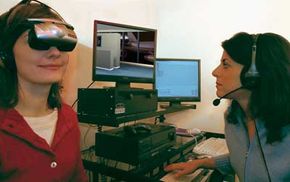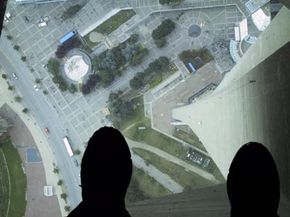Millions of people suffer from phobias that limit their activities and negatively impacting their lives. Many seek psychological treatment in order to manage or conquer their fears. For years, a popular form of treatment was exposure therapy, in which a therapist would expose a patient to stimuli related to his fear in a controlled environment. In many cases, patients would learn to manage their anxiety through repeated exposure coupled with encouragement from a therapist.
Exposure therapy is time consuming. Often it's also expensive and inconvenient, and it can compromise patient confidentiality. For example, treating a patient with aerophobia, or the fear of flying, usually involves a trip to the airport. It might take several visits for a therapist and patient to make their way through security to a gate. Eventually both have to get on a plane and fly to a destination. Now that you have to be a ticketed passenger to pass through security at airports, it can be prohibitively expensive to treat a patient with exposure therapy. Because patients and therapists travel together, the patient's confidentiality is compromised because the public has the opportunity to see the therapy in action.
Advertisement
One alternative to traditional exposure therapy is virtual reality exposure therapy. This kind of therapy uses a virtual reality unit to simulate situations that cause anxiety in phobia patients. It has several advantages over traditional therapy. Doctors don't have to leave their offices. Scheduling treatment is easier. It's less expensive in the long run. And patients are often more willing to participate in a program they know will allow them to deal with their fears in a nonphysical setting. Since patients can undergo therapy inside the doctor's office, confidentiality isn't an issue.
Dr. Larry Hodges, a virtual reality computer scientist at the University of North Carolina -- Charlotte, became interested in a possible therapeutic application of VR technology in the early 1990s. He approached Dr. Barbara Rothbaum, a professor of Psychiatry at Emory University, and together they collaborated on a project that would test VR technology's efficacy in recreating patients' fears. They decided to design a simulation for patients suffering from acrophobia, or a fear of heights. Dr. Hodges felt that it would be relatively easy to create a program giving the illusion of height compared to other, more complex fears.
Dr. Hodges and his team worked with Dr. Rothbaum and volunteer patients to determine what stimuli were particularly powerful. Volunteers would wear a head-mounted display (HMD) that would create the illusion that they were on a tall ledge. Going into the project, Hodges and Rothbaum weren't certain that they would get the same reactions from volunteers in a virtual environment as they would a real one, nor were they sure that by treating someone using virtual environments that progress would translate into the real world.
Advertisement



